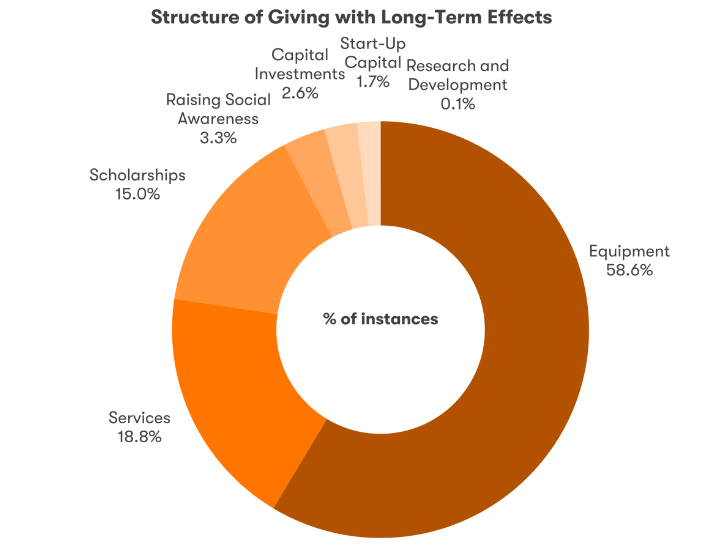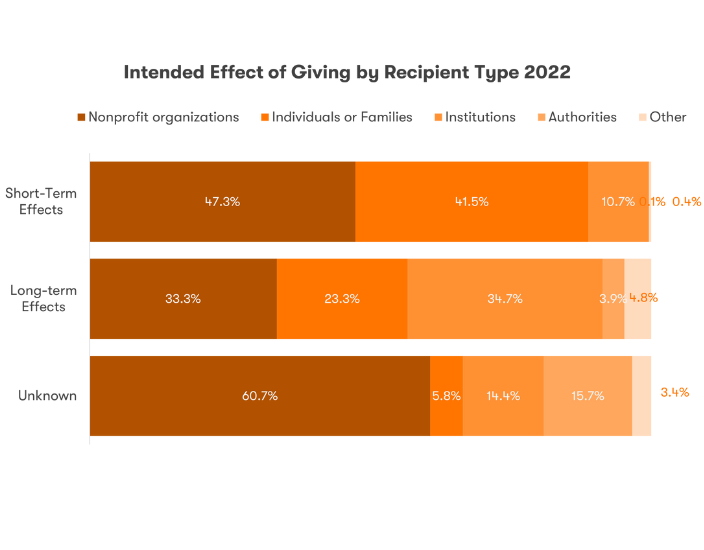The use of donations can be categorized based on the intended effect that a donation has on the issue that it aims to help. Accordingly, the use of donations is categorized as either donations with intended short-term effects or long-term effects. Donations with intended long-term effects refer to support that is supposed to provide beneficiaries with strategic solutions to their problems, while donations with intended short-term effects aim to address immediate issues in society.

Graph 1: Trends in intended Effects of Giving in Serbia – 2018 – 2022 (% of instances)
The share of instances with short-term effects increased until 2021 when it reached it’s peak, followed by a decrease in 2022. The decrease was due to the increase in donation instances for which the effects were not able to be distinguished. Still, donations with short-term effects were the most common form of donations in Serbia in 2022. On the other hand, donations with intended long-term effects had a share of around one quarter of all donation instances.
Breakdown of Short-Term Effect Giving in 2022

Graph 2: Structure of Short-Term Effect Giving in Serbia in 2022
Donations with intended short-term effects comprised of 61.6% of all donation instances and 73.7% of the total donated amount. From the total short-term donation instances, medical treatments generated 42.1%, followed by donations of supplies and consumables (29.4%), humanitarian support (22.6%) and individual housing (5.9%). Regarding the value of donations with short-term effects, medical treatments generated the highest share 77.9% of the total value, followed by humanitarian support (16.3%).
Breakdown of Long-Term Effect Giving in 2022

Graph 3: Structure of Long-Term Effect Giving in Serbia in 2022
Donations with intended long-term effects comprised 26.7% of all donation instances and 17.1% of the total donated amount. Although donations with intended long-term effects are generally of higher value than donations with short-term effects, this low share is a result of the high value of donation which was intended for medical treatments of large value. Additionally, for many recorded strategic donations in 2022 there was no data available on the value of donations. Regarding the type of long-term support, donations of equipment were most prominent and these also included donations intended for the renovation and restauration of institutions, building and other residences. Equipment comprised 58.6% of the total number of instances and 67.7% of the total donated amount for long-term giving. Services were the second most frequent form of long-term support in Serbia in 2022, generating 18.8% of donation instances with long-term effects.
Intended Effects of Giving by Recipient Types
In 2022, around half of all giving with short-term effects was directed to nonprofit organizations. Donations with intended short-term effects were directed to individuals and families in need in 41.5% of all cases, while giving to the state generated a much smaller share.
Regarding strategic giving, nonprofit organizations were the recipient in around a third of all donation instances with long-term intended effects. Institutions had a slightly higher percentage in this distribution, while giving directly to individuals and families comprised 23.3% of all giving with long-term effects.

Graph 4: Structure of Intended Effects of Giving by Recipient Type in Serbia in 2022
Use of Donation by Recipient Types

Graph 5: Structure of Use of Donation by Recipient Type in Serbia in 2022
Regarding the channels of giving for specific use of donations in Serbia, it is notable that donations intended for medical treatments, services, organizational support and capital investments were mainly provided through the work of the nonprofit sector. On the other hand, donations for providing humanitarian support, individual housing, and scholarships were donated directly to individuals and families in need.
Examples of Giving
Save food, Save Humanity
Nestlé company donated 17+ tons of food products to Serbian food banks as part of the "Save Food, Save Humanity" campaign. Deliveries covered regions like Vojvodina, Belgrade, Niš, and the Federation of Food Banks in Serbia.
Contributions of small and medium sized enterprises
Bosis d.o.o. Valjevo received the VIRTUS Award for philanthropy twice. They invested €12,800 in 2022, aiding disadvantaged families and children with disabilities in Kolubara. Their initiatives included cultural support, food, hygiene packages, and New Year's gifts.
Giving by corporate foundations
The SBB Foundation yearly donates €10,000 to associations. In 2022, the Evo Ruka association received funding for a facility renovation. SBB Foundation also supported Užice Women’s Center and BELhospice.
The Annual report Giving Serbia 2022 was supported by the C. S. Mott Foundation and the Rockefeller Brothers Fund. The views expressed on this web page do not necessarily reflect the views of the C. S . Mott Foundation and the Rockefeller Brothers Fund and their partners.


Leave a comment